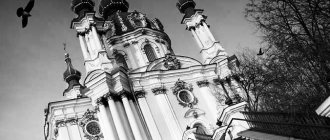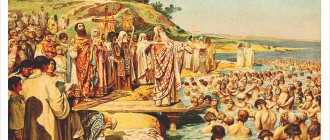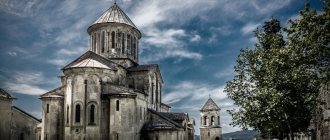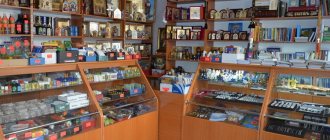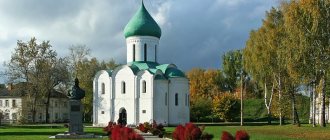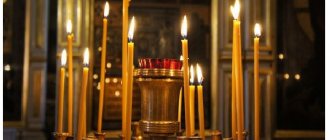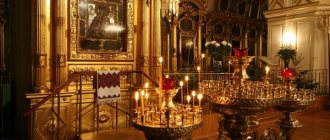What is the name of the candlestick in the temple? A candlestick in a temple is an integral attribute of church decoration; it is known that candles are widely used in Christianity, and candlesticks for them are present in large quantities in every temple. Candlesticks in a temple require careful care - to keep them in good shape, they need to be regularly cleaned of wax, dust and dirt. Not everyone knows how to properly clean a candlestick in a temple, and we must admit that this task is not an easy one. Read the next article on the pages and you will learn how to clean the candlesticks in the temple so that they shine.
What is a church candlestick?
In a Russian Orthodox church you can see many candlesticks, designed for parishioners to light candles in front of the icons.
The most common design these days is a rectangular or round table on a high leg with many holes for candles. Sometimes a candlestick for many candles is called polycandyl
, although more often this word refers to a small
temple chandelier
with several light sources.
How to clean candlesticks in a temple to make them shine
Portable, altar, altar, deacon and other candlesticks can be very quickly cleaned of wax, even if there is a lot of wax on the candlesticks. There are several methods you can use to remove wax from candle holders.
Method 1: you need to boil the kettle and take the candlestick (having previously removed the candle) with the kettle outside the temple, find an untrodden place (you need to understand that the wax from the candles from the altar, when they stand near the altar, cannot be washed into the sewer) and start watering the places accumulation of wax on a candlestick with boiling water.
We recommend reading: Candles for the Guardian Angel
The wax will melt and wash off with hot water. After washing off the drops of wax, you should wipe the places where they were previously with a soft cloth to remove any remaining wax deposits and then wipe the entire candlestick to remove moisture from it.
Method 2: you need to heat the wax with warm air from a hairdryer and wipe it with a napkin. The candlestick will shine like new.
Sources:
- https://v-hram.ru/articles/podsvechniki/
- https://xn—-ptbdbgndbgtdm2excr.xn--p1ai/raznoe/podstavka-dlya-svechej-kak-nazyvaetsya-kak-nazyvaetsya-dekorativnaya-podstavka-dlya-neskolkix-svechej-ili-lamp.html
- https://blagvist.com.ua/zametki/kak-ochistit-podsvechnik-ot-gari-i-voska.html
- https://uk.axios.world/news/kak-uhazhivat-za-pozolochennymi-i-poserebrennymi-izdeliyami-tserkovnoy-utvari.html
- https://ponomari.ru/kb/kak-bystro-ochistit-podsvechnik-ot-voska/
Varieties
- Central
candlestick is usually the largest. A lamp is usually installed in the center of such a candlestick.
- Regular
candlesticks - placed in front of icons, relics, crucifixes.
They can be round or multifaceted, less often rectangular, with
or without a lamp.
- Children's
floor candlesticks
differ from adults in being smaller in height. Thanks to this, it is convenient for children to place candles on them.
- Eve
(
canon, tetrapod
) – funeral candlestick, funeral table.
- Hanging candlesticks (kandila)
. They are much less common than floor-mounted ones. In Orthodox churches, they are usually placed in front of revered icons. Such a candlestick may have holes for one or more candles, as well as a glass for a lamp.
About altar candlesticks and lamps
Altarpiece - a candlestick installed by the priest. Under a church candle, one used during services. Altar candlesticks are always paired. Each of them contains one large and beautiful candle. These utensils are installed on the eastern ends of the throne - from the north and from the south.
Lamps come in two main types, according to their purpose and method of use. The first type is a church candlestick, semi-closed and, as a rule, hung on the wall. There are also lamps that are not intended for candles, but are simply filled with oil. They were the first Christian lamps. Such lamps are not used in divine services; their function is only one - to illuminate the temple premises.
The second type of lamps is used during church services. This is a portable candlestick carried by a deacon and called a “kandil”. Often such utensils are called polyeleos candlesticks.
Helpful advice
Before you start placing candles on a metal candlestick, generously lubricate it with lamp oil. This will make it easier to clean the candlestick from frozen drops of wax and protect it from damage.
According to fire safety requirements, the candlestick must be placed on a non-flammable surface. In addition, you should take care that the wax does not fall on the temple floor, otherwise stains will remain on it. Therefore, in many temples, candlesticks are placed on special circle-backings made of suitable materials.
How to properly clean a candlestick in a temple
First of all, remove wax and dust from the surface of the product.
Nowadays, there are a number of chemical products designed to clean gold-plated and silver-plated items. The most popular among them are products based on asidol, which are sold under the same name, and imported products, for example, Glutoclean brand household chemicals.
Recommendations for cleaning church utensils
First of all, remove wax and dust from the surface of the product. The wax can be washed off by simply pouring boiling water over the item. Do not forget that the metal heats up after this procedure, so be careful.
In the most difficult cases, the wax mixes with dust and can be difficult to remove with hot water, especially if it has accumulated in the enamel painting of the product. Then you should use chemical wax removers. Finally, wipe the product dry with a paper towel.
Check the item for rust or oxidation films that may have been hidden under a layer of wax. They should be removed with a special rust remover. If the metal base is severely damaged, and the product itself is of great value, it is better to give it to a professional restorer.
If you properly remove dirt and grime from an object, you can bring it to a shine. To obtain a gloss, use metal polishes or simply rub the product with a paper towel.
It is important to remember the main rule - constant and attentive care, better than rare cleaning using abrasives and chemicals. Take care of church utensils - they will be able to perform their practical functions for a long time, and also serve as a symbol of that spiritual purity that should always be in our hearts.
From the history
In the old days in Russia there was such a variant of a floor candlestick for a temple as a skinny
(or stand-up) candle
. This is a candlestick, the leg of which is made in the form of a cylindrical column and itself resembles a huge candle. As a rule, such candlesticks were decorated with rich paintings or carvings. Initially, they were made from a wooden block that was hollow inside, and later from porcelain. The ornament that adorned the “skinny candle” symbolized the tabernacles of paradise and was an interweaving of strange plants.
About the seven-branched candlestick
This type of candlestick is rarely found in modern churches. In city churches it was replaced by electric lamps, similar in appearance to a candlestick.
This is a church floor candlestick. It is designed for seven candles or has inserts for the same number of lamps. This type of utensil is traditionally installed on the eastern side of the throne in the amount of one piece. However, during large services the number of seven-branched candlesticks can be increased and their location changed.
The most important part of the temple is the altar . In the altar, Divine services are performed by the clergy and the most sacred place in the entire temple is located - the holy altar , on which the sacrament of Holy Communion is performed. The altar is placed on a raised platform. It is higher than other parts of the temple, so that everyone can hear the service and see what is happening in the altar.
The throne is a specially consecrated quadrangular table, located in the middle of the altar and decorated with two clothes: the lower one is white, made of linen, and the upper one is made of more expensive material, mostly brocade. On the throne, mysteriously, invisibly, the Lord Himself is present, as the King and Ruler of the Church. Only clergy can touch and kiss the throne.
On the throne there is an antimension, a Gospel, a cross, a tabernacle and a monstrance.
An antimension is a silk scarf (scarf) consecrated by a bishop, with a depiction on it of the position of Jesus Christ in the tomb and, necessarily, with a particle of the relics of some saint sewn on the other side, since in the first centuries of Christianity the Liturgy was always performed at the tombs of martyrs. Without an antimension, the Divine Liturgy cannot be celebrated (the word “antimension” is Greek, meaning “in place of the throne”).
For safety, the antimension is wrapped in another silk board called iliton . It reminds us of the sir (plate) with which the Savior’s head was wrapped in the tomb.
On the antimension itself there is a lip (sponge) for collecting particles of the Holy Gifts.
The Gospel is the word of God, taking into account our Lord Jesus Christ.
The cross is the sword of God, with which the Lord defeated the devil and death.
The tabernacle is the name given to the ark (box) in which the Holy Gifts are stored in case of communion for the sick. Usually the tabernacle is made in the form of a small church.
The monstrance is a small reliquary (box) in which the priest carries the Holy Gifts for communion with the sick at home.
Behind the throne there is a seven-branched candlestick , that is, a candlestick with seven lamps, and behind it an altar cross . The place behind the throne at the very eastern wall of the altar is called the mountain (high) place ; it is usually made sublime.
To the left of the throne, in the northern part of the altar, there is another small table, also decorated on all sides with clothes. This table is called an altar . Gifts for the sacrament of communion are prepared on it.
On the altar are the sacred vessels with all their accessories, namely:
1. Holy Chalice , or chalice , into which before the Liturgy wine and water are poured, which are then offered, after the Liturgy, into the blood of Christ.
2. Paten - a small round dish on a stand. Bread is placed on it for consecration at the Divine Liturgy, for its transformation into the body of Christ. The paten marks both the manger and the tomb of the Savior.
3. Star , consisting of two small metal arcs connected in the middle with a screw so that they can either be folded together or moved apart crosswise. It is placed on the paten so that the cover does not touch the particles taken out of the prosphora. The star symbolizes the star that appeared at the birth of the Savior.
4. Spear knife, similar to a spear, for removing the lamb and particles from the prosphora. It symbolizes the spear with which the soldier pierced the ribs of Christ the Savior on the Cross.
5. Liar - a spoon used to give communion to believers.
6. Sponge or cloth - for wiping blood vessels.
Small covers that cover the bowl and paten separately are called covers . The large cover that covers both the cup and the paten together is called air , signifying the air space in which the star appeared, leading the Magi to the manger of the Savior. Nevertheless, together the covers represent the shrouds with which Jesus Christ was wrapped at birth, as well as His burial shrouds (shroud).
All these sacred objects must not be touched by anyone except bishops, priests and deacons.
On the altar there is also a ladle in which, at the beginning of the proskomedia, wine and water are served to be poured into the holy cup; then, before communion, warmth (hot water) is supplied in it, and the drink after communion is taken out in it.
In the altar there is also a censer or censer - a vessel mounted on a chain that distributes fragrant smoke - incense (incense). Ceremony was established in the Old Testament church by God Himself. Ceremony before St. the throne and icons expresses our respect and reverence for them. Every prayer addressed to those praying expresses the wish that their prayer would be fervent and reverent and would easily ascend to the sky, like incense smoke, and that the grace of God would overshadow the believers as the smoke of incense surrounds them. Believers must respond to incense with a bow.
The altar also contains dikiriy and trikyriy , used by the bishop to bless the people, and ripids .
A dikirie is a candlestick with two candles, symbolizing the two natures in Jesus Christ - Divine and human.
A trikirium is a candlestick with three candles, symbolizing our faith in the Holy Trinity.
Ripids or fans are metal circles attached to the handles, with images of cherubs on them. Deacons blow ripids over the gifts during their consecration. Previously, they were made from peacock feathers and were used to protect St. Gifts from insects. Now the spirit of ripid has a symbolic meaning; it depicts the presence of heavenly forces during the sacrament of Communion.
On the right side of the altar there is a sacristy . This is the name of the room where vestments are stored, that is, sacred garments used during Divine services, as well as church vessels and books with which Divine services are performed.
In front of the icons and lecterns there are candlesticks on which believers place candles. Parishioners take candles from a candle box - a special place at the entrance to the temple. A lit candle means our fiery love for God, the Most Holy Theotokos and all the saints to whom we turn with prayers.
In a special place of the temple (usually on the left side) a kanun - a small table with an image of the Crucifixion and cells for candles, which believers place for the repose of loved ones, relatives and friends.
In the middle of the temple, at the top of the ceiling, hangs a chandelier , that is, a large candlestick with many candles. The chandelier is lit during solemn moments of the service.
The following works were used in preparing the material: “The Law of God,” Archpriest Seraphim Slobodskaya. “Orthodoxy for children”, O.S. Barilo.
Production of utensils
The presence of a huge number of Orthodox churches in Russia requires mass production of church utensils. There are quite a lot of factories and workshops that offer a choice of their goods, but the official and main enterprise among them is Sofrino, whose church utensils are directly produced by the Moscow Patriarchate. This is a large plant serving all of Russia and some CIS countries. It is located in the Moscow region in the settlement of the same name.
There are internal regulations for the clergy that prohibit or limit the acquisition of necessary religious items anywhere other than Sofrino. At the same time, church utensils are extremely expensive and often lack quality, which clergy often complain about.
Alternative factories produce products of an order of magnitude better quality, both in terms of internal characteristics and visual ones. They are located in various cities and regions. But the main place of concentration of enterprises where church utensils are produced is Moscow.
About dikiriy, trikirium and candlestick for one floor candle
Dikiriy, like trikiriy, is a festive, ceremonial utensil. Bishops use it when performing solemn services. Two candles are installed in the dikiri, and three, respectively, in the other candlestick. During the course of the service, the bishops bless the believers with their help. The candles used in these types of utensils have their own names - autumn, two- or three-wicker.
It is rare now to see a large and heavy candlestick standing on the floor in an active temple. Due to electrification, there was no place left in the halls for a church candle, large and burning for a long time. Although some churches have preserved this utensil and use it to decorate the room before special services, it is easier to see such a candlestick in museums than in churches. This type of candlestick is called “voshchanitsa”. Externally, it is a cylindrical candle stand placed on a high “leg”, fancifully and extremely richly decorated.

